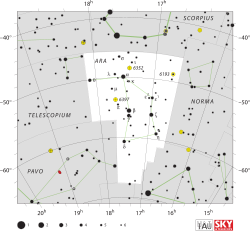Epsilon1 Arae
| Observation data Epoch J2000.0 Equinox J2000.0 | |
|---|---|
| Constellation | Ara |
| Right ascension | 16h 59m 35.048s[1] |
| Declination | −53° 09′ 37.58″[1] |
| Apparent magnitude (V) | +4.068[2] |
| Characteristics | |
| Spectral type | K3 III[3] |
| U−B color index | +1.71[4] |
| B−V color index | +1.45[4] |
| Astrometry | |
| Radial velocity (Rv) | +23.85±0.03[5] km/s |
| Proper motion (μ) | RA: +1.015 mas/yr[1] Dec.: +21.455 mas/yr[1] |
| Parallax (π) | 8.8520±0.1517 mas[1] |
| Distance | 368 ± 6 ly (113 ± 2 pc) |
| Absolute magnitude (MV) | −0.79±0.16[6] |
| Details[5] | |
| Mass | 1.63±0.21 M☉ |
| Radius | 29.52±2.45 R☉ |
| Luminosity | 347+90 −71 L☉ |
| Surface gravity (log g) | 1.85±0.07 cgs |
| Temperature | 4,302±45 K |
| Metallicity [Fe/H] | −0.19±0.06 dex |
| Rotational velocity (v sin i) | 4.20±0.45 km/s |
| Age | 1.82±0.60 Gyr |
| Other designations | |
| CPD−52°10372, FK5 632, GC 22869, HD 152980, HIP 83153, HR 6295, SAO 244331, PPM 345574[7] | |
| Database references | |
| SIMBAD | data |
Epsilon1 Arae is a star in the southern constellation Ara, the Altar. Its name is a Bayer designation that is Latinized from ε1 Arae, and abbreviated Epsilon1 Ara or ε1 Ara. This star is visible to the naked eye with an apparent visual magnitude of +4.1[2] Based upon an annual parallax shift of 8.85 mas,[1] this star is approximately 368 light-years (113 parsecs) distant from the Earth. It is drifting further away with a radial velocity of +24 km/s.[5]
ε1 Arae is an evolved giant star[8] with a stellar classification of K3 III.[3] It is around 63% more massive than the Sun. At an age of about 1.8 billion years, the outer envelope of the star has expanded to almost 30 times the Sun's radius. It is radiating 347 times the luminosity of the Sun from its photosphere at an effective temperature of 4,302 K,[5] giving it the orange-hued glow of a K-type star.[9]
ε1 Arae was known as 龜一(spelled as "Guī yī", meaning: "the 1st (star) of Guī") in traditional Chinese astronomy.[10][11] Allen erroneously called it Tso Kang (左更).[12] He probably confused the constellation "Ara" with "Ari", as Tso Kang is actually in Aries.[10][11]
References
[edit]- ^ a b c d e Brown, A. G. A.; et al. (Gaia collaboration) (2021). "Gaia Early Data Release 3: Summary of the contents and survey properties". Astronomy & Astrophysics. 649: A1. arXiv:2012.01533. Bibcode:2021A&A...649A...1G. doi:10.1051/0004-6361/202039657. S2CID 227254300. (Erratum: doi:10.1051/0004-6361/202039657e). Gaia EDR3 record for this source at VizieR.
- ^ a b Soubiran, C.; et al. (June 2010), "The PASTEL catalogue of stellar parameters", Astronomy and Astrophysics, 515: A111, arXiv:1004.1069, Bibcode:2010A&A...515A.111S, doi:10.1051/0004-6361/201014247, S2CID 118362423.
- ^ a b Houk, Nancy (1978), Michigan catalogue of two-dimensional spectral types for the HD stars, vol. 2, Ann Arbor: Dept. of Astronomy, University of Michigan, Bibcode:1978mcts.book.....H.
- ^ a b Johnson, H. L.; et al. (1966), "UBVRIJKL photometry of the bright stars", Communications of the Lunar and Planetary Laboratory, 4 (99): 99, Bibcode:1966CoLPL...4...99J.
- ^ a b c d Jofré, E.; et al. (2015), "Stellar parameters and chemical abundances of 223 evolved stars with and without planets", Astronomy & Astrophysics, 574: A50, arXiv:1410.6422, Bibcode:2015A&A...574A..50J, doi:10.1051/0004-6361/201424474, ISSN 0004-6361.
- ^ Setiawan, J.; et al. (July 2004), "Precise radial velocity measurements of G and K giants. Multiple systems and variability trend along the Red Giant Branch", Astronomy and Astrophysics, 421: 241–254, Bibcode:2004A&A...421..241S, doi:10.1051/0004-6361:20041042-1.
- ^ "eps01 Ara". SIMBAD. Centre de données astronomiques de Strasbourg. Retrieved 2012-07-28.
{{cite web}}: CS1 maint: postscript (link) - ^ da Silva, L.; et al. (November 2006), "Basic physical parameters of a selected sample of evolved stars", Astronomy and Astrophysics, 458 (2): 609–623, arXiv:astro-ph/0608160, Bibcode:2006A&A...458..609D, doi:10.1051/0004-6361:20065105, S2CID 9341088.
- ^ "The Colour of Stars", Australia Telescope, Outreach and Education, Commonwealth Scientific and Industrial Research Organisation, December 21, 2004, archived from the original on 2012-03-18, retrieved 2012-07-21.
- ^ a b Chevalier, S., and Tsuchihashi, P., (1911): "Catalogue d'Étoiles fixes, observés a Pekin sous l'Empereur Kien Long (Qianlong (Chien-Lung)), XVIIIe siecle", Annales de l'Observatoire Astronomique de Zô-Sé.
- ^ a b 伊世同 (Yi Shi Tong) (1981): 『中西対照恒星図表』科学出版社.(in Chinese)
- ^ Allen, R. H. (1963), Star Names: Their Lore and Meaning (Reprint ed.), New York, NY: Dover Publications Inc., p. 64, ISBN 0-486-21079-0.
{{citation}}: ISBN / Date incompatibility (help)

